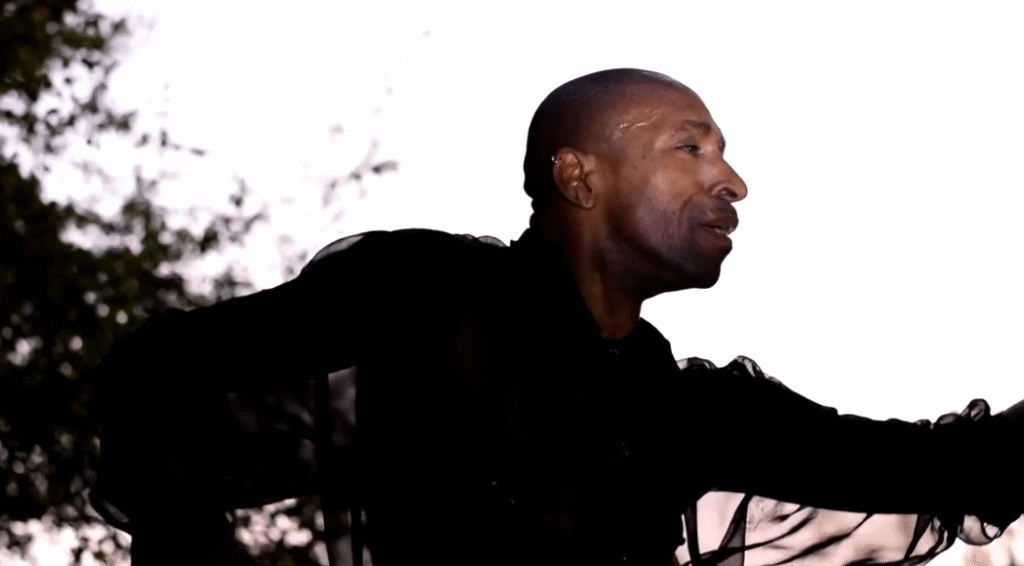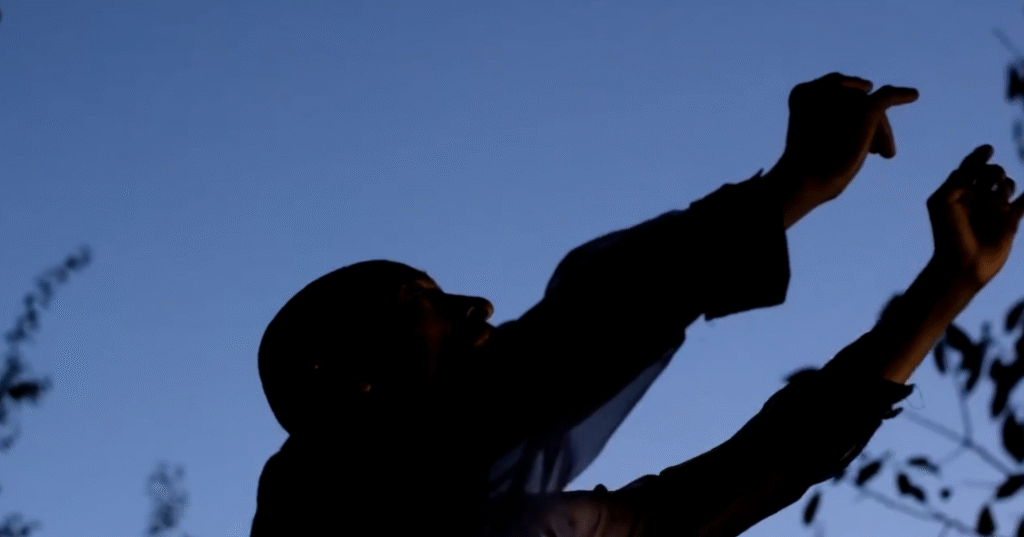Kicking off the three-part series Butoh Art Attack Tacoma, a free screening was held on May 17 at the Tacoma Armory , showcasing three films by South African Butoh artist Tebby Ramasike.. Although he was unable to attend in person due to visa issues, the audience was treated to recordings of three of his powerful performances.
Following the films, the evening continued with two live performances. The first was by dancer Helen Thorsen, a founding member of Seattle’s Dappin Butoh and Yuni Hoffman Dance Theater. Thorsen is currently the managing director of Seattle’s DAIPANbutoh Collective. Viewing dance through a therapeutic lens, her background spans disciplines including Butoh, yoga, Tai Chi, and more. She also served as the evening’s emcee, introducing Ramasike’s work and contextualizing the recordings.
The second performance featured Lin Lucas an African-American dancer from Earthseed Rising in Tucson, AZ. Through Butoh, art and dream work he engages in ancestral lineage healing. He is also a comic book creator and writer of short stories, screenplays, and poetry.
Each of the live performances were accompanied by the Seattle-based, experimental violinist Jackie An, a neurodivergent, non-binary, Korean-American artist whose musical and empathic talents enhanced the improvisational collaborations. All three performers participated in a post-show discussion that was both invigorating and thought-provoking.
Reflections on Ramasike’s Films
The first work by Ramasike was a selection from “In the Shadow of Darkness”, filmed at the Sesalac Butoh Retreat in Serbia. The video can be viewed on YouTube here. Watching the performance, set against an experimental musical backdrop, I was reminded of Butoh’s origins—born in postwar Japan as an embodied expression of trauma, tension, and release. It’s a form that summons pain, processes it somatically, and purges it.
Hijikata Tatsumi’s original Butoh drew influence from German Expressionism and Antonin Artaud’s Theater of Cruelty, as well as Japan’s subconscious—its folklore, spirits (Yokai), and native shamanic traditions.


The second video was incredibly moving – it was a selection from “The Wreakage of My Flesh”, performed at the Musee National de la Resistance Esch-Sur-Alzette, which preserves the memory of Luxembourg’s victors of the Nazi Occupation. The full recording can be found on YouTube here.

In this piece we see figures suspended in what resemble amniotic sacks. A dancer on the floor writhes in a similar sack and struggles to break free. The room has bars on one wall, like a prison. The African figure breaks free and still writhes in pain, attempting to reach out to the remaining, suspended figures. There are phrases on the wall: “I am alive and I am dead”…and “…never return from Auschwitz”. A European figure appears, gently placing a white cloth over him—perhaps an act of comfort, though the gesture is ambiguous: Is it care, or another form of entrapment?
The last one was “In Search of a Soul: a Blind man’s cry….the appeal” – which was performed at a Butoh festival at Espace Culturel Bertin Poiree de Tenri, in Paris. A copy can be viewed on YouTube here but the film is a bit grainy. In this work we see the dancer performing in what appear to be a pile of dried, golden leaves. He dances frantically, showering himself with the leaves. He thrashes and throws his body about, as if aggressively seeking stimulus from a world he cannot see.

The Live Performances
Helen Thorson’s performance was entitled “Kintsugi” – named after the Japanese art of taking broken pottery and mending it with gold as a meditative act of transformation. Her dance was inspired by the release of Lenord Pelitier after 40 years in prison. This piece was heavy, intense, unpredictable, and frightening. A figure slowly crawls out of a room, still dragging chains attached to their feet. The figure struggles to stand and move about, as if fighting to re-learn how to live in a world outside.

Lin Lucas’ piece was entitled “Blind at the Gates of Grief”, served as an exploration of loss and desire. He drew influence from Butoh founder Tatsumi Hijikata’s “Blind Girl” and Francis Wellers’ book From the Wild Edge of Sorrow: Rituals of Renewal and the Sacred Work of Grief.

Each station, illuminated by a single candle, marked a passage—love, desire, grief. At each point he embodied the various struggles, before collapsing and snuffing out a flame. At one point, he dug dirt from a beach bag and covered himself with it. At another, he cradled a bouquet of roses, then tore them apart, sparing one, which he inhaled deeply before extinguishing that station’s light with the very rose. Each moment unfolded with raw beauty and sorrow—expressions of grief and longing beyond language.

Final Thoughts
During the closing discussion, two powerful themes emerged. First, that Butoh is a profoundly therapeutic practice—one that helps people access and process trauma held within the body. Second, much of Butoh operates on a pre-verbal, primal level—expression that comes before language, or even thought. One story recounted an artist bringing Butoh into a prison, where over time, participants found they could access deep-seated traumas—eventually finding the words to describe them, thanks to the embodied work that came first.
Helen Thorsen will offer a free Butoh workshop at the Tacoma Armory on May 24, from 1–3 PM.
Fresh Ground Butoh Dances will perform on May 31 at 8 PM, also at the Tacoma Armory. Tickets are $20, and the show will feature six dancers accompanied by three musicians.


